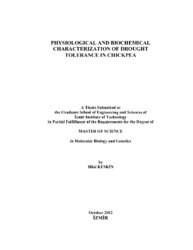Please use this identifier to cite or link to this item:
https://hdl.handle.net/11147/3547Full metadata record
| DC Field | Value | Language |
|---|---|---|
| dc.contributor.advisor | Frary, Anne | en |
| dc.contributor.author | Keskin, Hilal | - |
| dc.date.accessioned | 2014-07-22T13:51:46Z | - |
| dc.date.available | 2014-07-22T13:51:46Z | - |
| dc.date.issued | 2012 | en |
| dc.identifier.uri | http://hdl.handle.net/11147/3547 | - |
| dc.description | Thesis (Master)--Izmir Institute of Technology, Molecular Biology and Genetics, Izmir, 2012 | en |
| dc.description | Includes bibliographical references (leaves: 47-56) | en |
| dc.description | Text in English; Abstract: Turkish and English | en |
| dc.description | ix, 56 leaves | en |
| dc.description.abstract | Chickpea (Cicer arietinum cv. Gokce.) is an agronomically and economically significant plant for Turkey. It is successfully grown under severe drought conditions which limit the growth of other plants. It is generally affected by terminal drought which causes retardation of flowering and decreases yield in Mediterranean and subtropical climates. The aim of this study was to determine significant factors which can be used to identify chickpea plant tolerance to drought stress. With this objective we assessed physiological (fresh and dry weight, relative and real water content) and biochemical (enzymatic and non-enzymatic antioxidants, malondialdehyde, total protein and phytohormone contents) parameters which were used to measure the impact of drought on chickpea. To determine drought's effects, we collected stressed (drought treated) and control (non drought treated) samples from the chickpea cultivar Gokce. Results showed that both fresh and dry weights of plants increased while real and relative water contents of plants decreased under drought stress. There was an increase in both malondialdehyde (MDA) and total protein contents under drought stress. Furthermore, glutathione reductase (GR) and catalese (CAT) enzyme activity increased in drought treated plants whereas guaiacol peroxidase (POD) and superoxide dismutase (SOD) enzyme activity decreased. Moreover, contents of indole acetic acid (IAA) and abscisic acid (ABA) increased in all tissue parts while contents of salicylic acid (SA), gibberellic acid (GA) and jasmonic acid (JA) increased in specific plant tissue parts during drought treatment. In conclusion it is obvious that all of these characters play essential roles in the drought tolerance of plants. | en |
| dc.language.iso | en | en_US |
| dc.publisher | Izmir Institute of Technology | en |
| dc.rights | info:eu-repo/semantics/openAccess | en_US |
| dc.subject.lcsh | Plant genetics | en |
| dc.subject.lcsh | Chemistry, Analytic--Quantitative | en |
| dc.subject.lcsh | Solution (Chemistry) | en |
| dc.subject.lcsh | Crops--Drought tolerance | en |
| dc.subject.lcsh | Catalase | en |
| dc.subject.lcsh | Chickpea | en |
| dc.subject.lcsh | Oxidation | en |
| dc.subject.lcsh | Mixtures | en |
| dc.subject.lcsh | Chemical reactions | en |
| dc.title | Physiological and biochemical characterization of drought tolerance in chickpea | en_US |
| dc.type | Master Thesis | en_US |
| dc.institutionauthor | Keskin, Hilal | - |
| dc.department | Thesis (Master)--İzmir Institute of Technology, Molecular Biology and Genetics | en_US |
| dc.relation.publicationcategory | Tez | en_US |
| item.grantfulltext | open | - |
| item.openairecristype | http://purl.org/coar/resource_type/c_18cf | - |
| item.cerifentitytype | Publications | - |
| item.openairetype | Master Thesis | - |
| item.languageiso639-1 | en | - |
| item.fulltext | With Fulltext | - |
| Appears in Collections: | Master Degree / Yüksek Lisans Tezleri | |
Files in This Item:
| File | Description | Size | Format | |
|---|---|---|---|---|
| T001067.pdf | MasterThesis | 5.51 MB | Adobe PDF |  View/Open |
CORE Recommender
Page view(s)
80
checked on Apr 22, 2024
Download(s)
106
checked on Apr 22, 2024
Google ScholarTM
Check
Items in GCRIS Repository are protected by copyright, with all rights reserved, unless otherwise indicated.